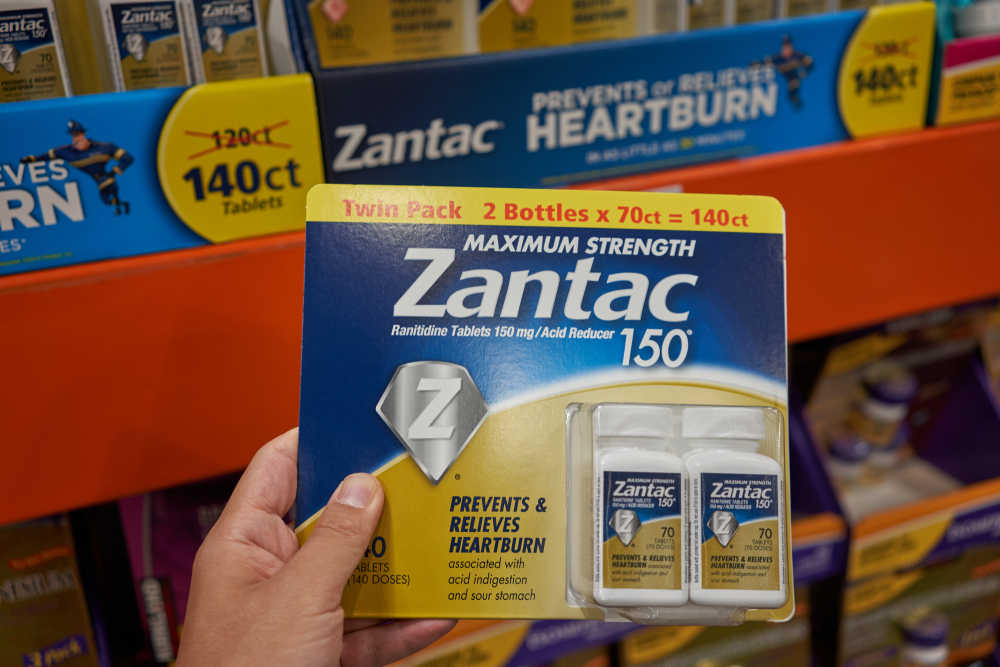By the late 1980s, Zantac had become the best-selling medication in the history of the world and one of the first ever to reach $1 billion in annual sales. But in the fall of 2019, multiple reports of tests emerged indicating that the key ingredient in Zantac, ranitidine, could cause cancer.
Recalls soon followed these reports of problems with Zantac, and today the drug is the subject of hundreds of lawsuits, including at least one class-action suit. If you or a loved one have taken Zantac or any of its generic versions, you should be aware of the issues surrounding the drug and what your rights may be to seek compensation for any injuries you suffered.
- What Is Zantac?
- Testing Reveals Troubling Findings
- Zantac and Other Ranitidine Products Recalled
- Alternatives to Zantac & Ranitidine
- Zantac & Cancer Risk
- Zantac Lawsuits
- What Should I Do if I Have Been Affected by Zantac?
- How Do I Know if I Qualify to Be Part of a Zantac Lawsuit?
- How Does a Zantac Lawsuit Work?
- How Long Does It Take to Settle a Zantac Lawsuit?
- What Is the Statute of Limitations on Zantac Lawsuits?
- How Much Can You Get From a Zantac Lawsuit?
- How Long Does It Take to Get Your Money After a Zantac Settlement?
What Is Zantac?
Zantac is the brand name for the drug ranitidine, which is used to treat and prevent heartburn. It’s sold in prescription and over-the-counter versions, and prescription versions of the drug have been used to treat more serious problems, like ulcers in the stomach and intestines. Glaxo Holdings, now part of GlaxoSmithKline, received U.S. approval to market ranitidine as Zantac in 1983; by 1988, Zantac had become a billion-dollar-per-year blockbuster medication.
Ranitidine is a histamine-2 blocker, or H2 blocker, which works by decreasing the amount of acid produced by the stomach. It’s been used to treat a variety of digestive-related conditions, including:
- Heartburn
- Esophageal inflammation
- Gastroesophageal reflux disease (GERD)
- Stomach ulcers
- Stress ulcers
- Over-production of stomach acid
- Zollinger-Ellison syndrome
- Gastritis
Testing Reveals Troubling Findings
Zantac’s chief ingredient is ranitidine, a histamine blocker that helps reduce stomach acid. During independent lab testing in the summer of 2019, samples of ranitidine showed high levels of a contaminant, N-Nitrosodimethylamine (NDMA), which is a probable human carcinogen.
The U.S. Food and Drug Administration conducted its own tests at the time and determined that NDMA levels were not high enough to pose a risk, but additional independent tests as well as a study conducted by the FDA indicated that ranitidine-based drugs stored for long lengths of time, especially at high temperatures, could have higher levels of NDMA. Some research has indicated that NDMA is also produced in the digestive systems of those who take ranitidine and Zantac, though the FDA’s testing did not reveal this.
NDMA is a byproduct of several natural and industrial processes. It’s present in low levels in certain foods, particularly those that are smoked or cured, but in high doses, it can be toxic to humans, causing organ damage in addition to being listed as a probable human carcinogen by the U.S. Environmental Protection Agency.
Before increased levels of NDMA were discovered in samples of ranitidine-based drugs, the volatile compound was at the heart of a 2018 recall of about half the U.S. supply of the blood pressure medication valsartan.
It’s suspected that valsartan, lorsartan, and irbesartan batches became contaminated with NDMA through a manufacturing process; with NDMA contamination in Zantac and ranitidine products, it’s believed that time and heat are the biggest culprits, at least as far as the FDA is concerned. But it’s crucial to note that testing on the drug is ongoing.
Zantac and Other Ranitidine Products Recalled
While Zantac’s prescription version was first marketed by Glaxo, the patent expired in 1997 and generic ranitidine competitors flooded the market, with companies like Pfizer, Johnson & Johnson, and Sanofi eventually all producing versions of the drug. Today, Sanofi holds the trademark for the Zantac brand, but more than 20 companies make over-the-counter ranitidine.
In April 2020, the FDA announced that it had ordered manufacturers to remove all prescription and over-the-counter versions of Zantac and other drugs containing ranitidine. Consumers shouldn’t take any versions of ranitidine heartburn drugs they currently have and should dispose of them safely. This represents millions of doses of the drug, with OTC and prescription sales of Zantac alone topping $220 million in 2018.
Affected manufacturers include:
- Sanofi
- American Health Packaging
- Northwind/Denton Pharma
- Appco Pharma
- Glenmark Pharmaceuticals
- Amneal Pharmaceuticals
- PrecisionDose Inc.
- GMSM Inc.
- Aurobindo Pharma
- Novitium Pharma
- Lannett Company
- Reddy’s Laboratories
- Perrigo Company
- Apotex Corp.
- Sandoz
Alternatives to Zantac & Ranitidine
Research has indicated that as many as 60 million Americans may be affected by occasional heartburn and acid reflux, and about 15 million have these symptoms every day. Chronic acid reflux can lead to a potentially serious condition, gastroesophageal reflux, also known as GERD. Symptoms of GERD include:
- Heartburn, often worse at night
- Chest pain
- Difficulty swallowing
- Feeling a lump in your throat
- Regurgitation of food or sour liquid
- Chronic cough
- Laryngitis
- Poor sleep
- New or worse asthma
People who have these symptoms more than a couple of times per week are encouraged to see a doctor, but they may wonder what alternatives exist to Zantac and other products containing ranitidine. While it’s always best to consult with your physician, it’s important to note that there are several other heartburn drugs that do not use ranitidine to block stomach acid production and have not been connected with contamination from NDMA. These include:
- Famotidine (Pepcid)
- Cimetidine (Tagamet)
- Esomeprazole (Nexium)
- Lansoprazole (Prevacid)
- Omeprazole (Prilosec)
Zantac & Cancer Risk
As mentioned, studies suggest that long-term storage of Zantac and ranitidine products may be tied to an increase in the cancer-causing substance NDMA. But it’s important to note that scientific study of this issue is ongoing, and other reasons for increased levels of NDMA in Zantac and related drugs could be revealed by that testing, including the possibility that ranitidine reacts with the human body in such a way that produces NDMA, as has been alleged by at least one laboratory.
Regardless of the reasons, dangerous levels of NDMA have been detected in ranitidine drugs from more than a dozen manufacturers, which seems to indicate the problems are widespread. In animal testing, even short-term exposure to NDMA was connected with liver damage and death in rats, hamsters, and mice.
Lawsuits already have been filed in the Zantac/ranitidine contamination case, and plaintiffs have developed a variety of types of cancer, possibly in connection with taking this drug. This includes the risk of cancer in virtually every part of the body, including:
- Bladder
- Brain
- Breast
- Esophagus
- Intestines
- Kidney
- Liver
- Lung
- Nose
- Ovaries
- Pancreas
- Prostate
- Stomach
- Testicles
- Throat
- Thyroid
- Uterus
Zantac Lawsuits
More than 200 lawsuits have already been filed against companies that make heartburn medications that contain ranitidine, and this includes individual actions and at least one class-action lawsuit.
Learn more about what the lawsuits are alleging and what you need to know if you took Zantac or another medication with ranitidine.
Defective Design
Testing by the independent laboratory Valisure, which first reported its findings to the FDA in 2019, indicates that ranitidine may be unsafe in any form due to what the lab calls “inherent instability.” In other words, the histamine-blocking key ingredient of Zantac and related drugs is too dangerous to be included in products that humans consume and using it as the basis of heartburn medication constitutes a fatal design flaw.
Some Zantac lawsuits include this allegation. All drug companies have a legal obligation to prevent foreseeable risk that results from how their products are designed and manufacturers, and some plaintiffs have alleged that companies failed in this responsibility because they should have known that ranitidine was too unstable for human consumption.
Improper Labeling & Failure to Warn
The second allegation that many plaintiffs are making is that Zantac and other ranitidine-based heartburn drugs did not warn consumers about the potential risk posed by the inclusion of ranitidine in the medication.
Zantac’s label warnings do not include any connection to an elevated cancer risk or even of any risk to exposure to NDMA, whether in drugs that have been stored for long periods of time or in the case of metabolic conversion of ranitidine to NDMA in the human digestive system.
Class-Action Lawsuits
Individual cases are proceeding against companies that make and sell Zantac and ranitidine-containing heartburn medications, but at least one class-action has been established in the Southern District of Florida.
What that means is that potential plaintiffs may soon have a chance to join a class-action, though they also can pursue individual claims against the makers of the drug.
What Should I Do if I Have Been Affected by Zantac?
If you or a loved one took Zantac or any other heartburn drug that contains ranitidine, whether by prescription or over-the-counter, you should immediately stop taking the medication and contact your doctor. This is particularly important for people who have regularly taken these medications to treat chronic or occasional heartburn, acid reflux, and other conditions.
Even if you have taken these drugs regularly, it’s unlikely you are in any immediate danger, but it’s important that you consult with your physician so that you can be examined for any potential health problems and so that you can receive recommendations for a safer drug to replace Zantac.
Plaintiffs in current litigation against Zantac companies have been diagnosed with many types of cancer, including some that are among the biggest cancer killers, such as lung cancer, breast cancer, brain cancer, and pancreatic cancer, which are expected to cause more than 250,000 deaths in the U.S. in 2020 alone.
Other health issues from possible NDMA exposure in ranitidine include headaches, fever, nausea, vomiting, and damage to kidneys, liver, and lungs, and it may be possible to seek financial compensation for these symptoms if they seriously impacted your life.
How Do I Know if I Qualify to Be Part of a Zantac Lawsuit?
Anybody who took Zantac or a related drug and later became ill, either with cancer or other health problems, could be eligible for compensation in a lawsuit. Those who were prescribed Zantac by a doctor may have an easier time with their legal claims thanks to the paper trail produced by their medical records, which would show that they filled a prescription for Zantac.
But most consumers take this drug over-the-counter, which means that it may be necessary to provide receipts for purchase to prove that you took the drug. Even those who took Zantac regularly but did not develop cancer may be eligible to participate in a Zantac lawsuit since many claims allege that manufacturers failed to live up to their responsibilities to warn consumers of the risks associated with their products.
How Does a Zantac Lawsuit Work?
Every case is unique, and many individual claims are currently working their way through the legal system. That said, cases against Zantac and other manufacturers that made ranitidine-based heartburn drugs have centered around one or both claims — these companies made a drug that was unsafe, and/or they failed to warn consumers of the inherent risks of the medication.
For those who are considering filing a Zantac lawsuit or joining a current or future class-action lawsuit, it will be crucial to prove that they took Zantac and were affected negatively by it in some way. In any case, consulting with a qualified attorney is the best way to ensure that you put yourself in the best position to seek justice for you and your family.
Do I Need a Lawyer to Join a Zantac Lawsuit?
While there is at least one class-action lawsuit pending against Zantac, this litigation remains in its early stages. What that means is that if you want to be sure you’ll have a good chance to make your case against the company that made the drug you took, consulting with a lawyer is currently the only viable way to do so.
Given the massive popularity of Zantac and widespread use of this medication, a Federal Multi District Litigation was created on February 6, 2020 consolidating the cases before one judge. This process allows cases to be filed in one place for purposes of discovering evidence and possible settlement of all claims Because this MDL litigation proceeding has started, especially for people who have become seriously ill as a result of taking ranitidine, time may be short.
Has There Been a Settlement in Zantac Lawsuits?
No, there currently has not been a settlement in any case relating to Zantac or other drugs that contain the potentially dangerous ingredient ranitidine. However, many legal observers will be closely watching lawsuits that are in their early stages, and the widespread availability of Zantac and other medications lends itself to the notion that a major settlement could be reached.
How Long Does It Take to Settle a Zantac Lawsuit?
There has been no settlement agreement yet in a Zantac lawsuit, so it’s not possible to say how long it might take to settle a case against a company that made a dangerous heartburn medication containing ranitidine.
With that said, cases like this typically are resolved within two to three years, though some have dragged on longer than that. Individual lawsuits sometimes can proceed more quickly, but with consumer-based lawsuits like claims against companies that make Zantac, that isn’t likely, given their increasing numbers.
What Is the Statute of Limitations on Zantac Lawsuits?
In every state, consumers have a set length of time to bring a lawsuit against a company. This depends on the state, as well as the allegations at the heart of the lawsuit, but in Zantac cases, the statute of limitations varies from just one year (in Kentucky, Louisiana, and Tennessee) to six years (in Maine and North Dakota).
The clock on the statute of limitations typically begins ticking from the date of the injury, which in cases of defective medications, usually means from the time a doctor diagnoses an illness and connects it with a particular cause. In other words, it’s likely you would need to file your case shortly after a doctor diagnoses you with an illness, such as cancer, that’s caused by ranitidine, Zantac, or a similar drug.
How Much Can You Get From a Zantac Lawsuit?
Because the cases surrounding Zantac and ranitidine are still unresolved, it’s difficult to predict what a typical settlement or verdict amount might be. However, plaintiffs in the cases that have been filed already have sought compensation for things like:
- Medical expenses (past and ongoing)
- Wage loss
- Loss of enjoyment of life
- Pain and suffering
- Punitive damages
We also can look to history to make some predictions about the financial compensation that could result from Zantac lawsuits. In other cases, pharmaceutical companies have reached multibillion-dollar settlements, including:
- Merck, $4.9 billion for arthritis drug Vioxx, which was connected to heart attack and stroke
- Wyeth, $3.8 billion for weight-loss supplement fen-phen, which caused fatal heart valve defects
- GlaxoSmithKline, $3 billion for kickbacks paid in promotion of antidepressants Paxil and Wellbutrin and Avandia, a diabetes medication
How Long Does It Take to Get Your Money After a Zantac Settlement?
The length of time a plaintiff can expect to wait to receive money following any legal settlement varies depending on a range of factors, but if Zantac cases proceeds as a major class-action lawsuit or mass action and a settlement is reached, consumers could be eligible to receive payment as little as six weeks after the settlement period begins.
Another factor is how much settlement money is available and what mechanism is developed to disburse settlement money. In some cases, it’s easy for consumers to receive compensation by filing a claim on a website and waiting a few weeks to receive a check; in other cases, those who wish to be compensated may need to do more work to verify their claims.





